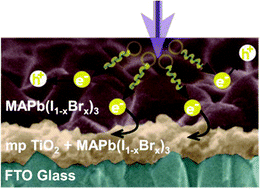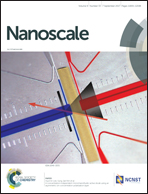Bromine substitution improves excited-state dynamics in mesoporous mixed halide perovskite films†
Abstract
In this study, ultrafast transient absorption spectroscopy (TAS) is utilized to examine the excited-state dynamics in methylammonium lead iodide/bromide (MAPb(I1−xBrx)3) perovskites as a function of bromide content. TAS spectral behavior reveals characteristic lifetimes for thermalization, recombination, and charge carrier injection of MAPb(I1−xBrx)3 from x = 0 to 0.3 infiltrated in mesoporous titania films. Carrier recombination and charge injection lifetimes demonstrated a discernable increase with Br content likely because high carrier populations are supported by the higher density of vacant electronic states in mixed-halide perovskites due to the increased capacity of the conduction band. However, we observe for the first time that carrier thermalization lifetimes significantly decrease with increasing Br. This suggests that the shift in crystal structure from tetragonal towards pseudocubic accelerates carrier cooling, resulting in the relief of the hot phonon bottleneck. Furthermore, the stabilized MAPb(I1−xBrx)3 samples exhibit a lower Burstein–Moss shift of 0.07–0.08 eV compared to pure MAPbI3 (0.12 eV). Our results provide evidence that Br inclusion contributes to a broadening of the parabolic conduction band and to improvement in electron–phonon coupling and phonon propagation in the lattice.



 Please wait while we load your content...
Please wait while we load your content...